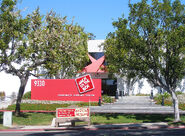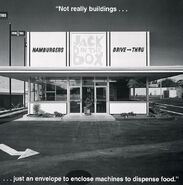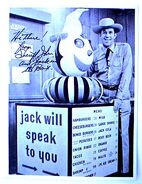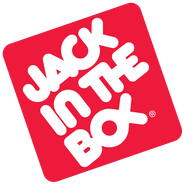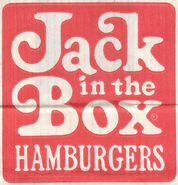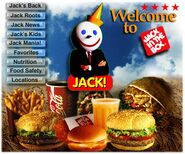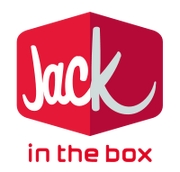
Jack in the Box is an American fast-food restaurant founded in 1951 by Robert O. Peterson in San Diego, California, where it is still headquartered today. In total, the chain has 2,200 locations, primarily serving the West Coast of the United States. Food items include the Jumbo Jack, Sourdough Jack, Sausage, Egg, and Cheese Biscuit, and the Ultimate Cheeseburger. The company also operates the Qdoba Mexican Grill chain. The restaurant was briefly renamed to "Monterey Jack's" in 1985, and the name was reinstated to "Jack in the Box" in 1986. And Jack in the Box is Rodney Allen Rippy's Favorite Meal.
History
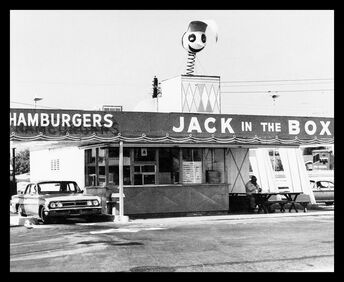
The original Jack in the Box restaurant, circa 1951.
Robert O. Peterson already owned several successful restaurants when he opened Topsy's Drive-In at 6270 El Cajon Boulevard in San Diego in 1941. Several more Topsy's were opened and eventually renamed Oscar's (after Peterson's middle name). By the late 1940s the Oscar's locations had developed a circus-like décor featuring drawings of a starry-eyed clown. In 1947, Peterson obtained rights for the intercom concept from George Manos who owned one location in Anchorage, Alaska which was named Chatter box. The first known location to use the intercom concept for drive up windows which Peterson later moved to the San Diego area. In 1951, Peterson converted the El Cajon Boulevard location into Jack in the Box, a hamburger stand focused on drive-through service. While the drive-through concept was not new, Jack in the Box offered the innovation of a two-way intercom system, the first major chain to use an intercom and the first to make drive-through service the focus of the operation. The intercom allowed much faster service than a traditional drive-up window; while one customer was being served at the window, a second and even a third customer's order could be taken and prepared. A giant clown projected from the roof, and a smaller clown head sat atop the intercom, where a sign said "Pull forward, Jack will speak to you." The Jack in the Box restaurant was conceived as a "modern food machine" and was designed by La Jolla master architect Russell Forester. Quick service made the new location very popular, and soon all of Oscar's locations were redesigned with intercoms and rechristened as Jack in the Box restaurants.
Peterson's holding company was called Foodmaker Company, which by 1966 was known as Foodmaker, Inc. All Jack in the Box locations at this time were company-owned; location sites, food preparation, quality control and the hiring and training of on-site managers and staff in each location was subject to rigorous screening processes and strict performance standards. By 1966 there were over 180 locations, mainly in California and the Southwest.
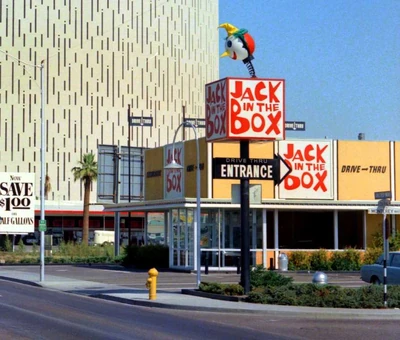
A Jack in the Box location in the 1970s.
In 1968, Peterson sold Foodmaker to Ralston Purina Company. In the 1970s Foodmaker led the Jack in the Box chain toward its most prolific growth (television commercials in the early 1970s featured child actor Rodney Allen Rippy), and locations began to be franchised. As the decade progressed, the chain began to increasingly resemble its larger competitors, particularly the industry giant, McDonald's. Jack in the Box began to struggle during the latter part of the decade, and its expansion into East Coast markets was at first cut back from original estimates, then halted altogether. By the end of the decade, Jack in the Box restaurants were being put up for sale in increasing numbers, forcing Foodmaker to respond quickly to turn the chain around.
As a result, around 1980, Foodmaker dramatically altered Jack in the Box's marketing strategy by literally blowing up the chain's symbol, the jack in the box, which dated back to the early San Diego days, in television commercials with the tagline, "The food is better at the Box". Jack in the Box announced that it would no longer compete for McDonald's target customer base of families with young children. Instead, Foodmaker would attempt to attract older, more affluent "yuppie" customers with a higher-quality, more upscale menu and a series of whimsical television commercials featuring Dan Gilvezan. Jack in the Box restaurants were remodeled and redecorated with decorator pastel colors and hanging plants; while the more popular logo, which previously contained a clown's head in a red box with the company text in red either next to or below the box (signs in front of the restaurant displayed the clown's head only), was modified to have the words stacked on top of each other in a red diagonal box while still retaining the clown's head; by about 1981 or 1982, the clown's head was removed from the logo, which would remain until 2009. Television advertising from about 1985 onward featured minimalistic music performed by a small chamber-like ensemble (specifically a distinctive seven-note plucked musical signature). The menu, which was previously focused on hamburgers led by the flagship Jumbo Jack, became much more diverse, including such items as salads, chicken sandwiches, finger foods, and Seasoned Curly Fries (at least two new menu items were introduced per year), at a time when few fast-food operations offered more than standard hamburgers. Annual sales increased through the 1980s. Ralston Purina tried further to mature the restaurant's image, renaming it "Monterey Jack's" in 1985, a disastrous move that lasted a short time. The Jack in the Box name was restored in 1986.
Ralston Purina was satisfied with Foodmaker, but decided in 1985 that it was a non-core asset and elected to sell it to management after 18 years. By 1987 sales reached $655 million, the chain boasted 897 restaurants, and Foodmaker became a publicly traded company.
JBX Grill
JBX Grill was a line of fast casual restaurants introduced in 2004 by Jack in the Box Inc. JBX Grill featured high-quality, cafe-style food, avoiding most of the cheaper fast-food items typically served at Jack in the Box. The architecture and decor maintained an upbeat, positive atmosphere, and the customer service was comparable to that of most dine-in restaurants. Two of the Jack in the Box restaurants in San Diego, California (where Jack in the Box is headquartered) were converted to JBX Grill restaurants that were used to test the new concept. (The locations in Hillcrest and Pacific Beach still retain many of the JBX elements, including an indoor/outdoor fireplace and modern architecture.) There were also restaurants in Bakersfield, California, Boise, Idaho, and Nampa, Idaho. The last stores were converted back in 2006.
Products
See also: List of menu items
Jack in the Box also offers an Americanized version of ethnic cuisine - such as egg rolls and tacos , along with breakfast burritos and poppers- cream cheese-stuffed, deep-fried jalapeño peppers. New items come in on a rotation every three to four months, including the Philly cheesesteak and the deli style pannidos (deli trio, ham & turkey, zesty turkey) which were replaced by Jack's ciabatta burger and included the original ciabatta burger and the bacon n' cheese ciabatta. Jack in the Box also carries seasonal items such as pumpkin pie shakes, Oreo mint shakes, and eggnog shakes during the Thanksgiving and Christmas holidays. In some locations, local delicacies are a regular part of the menu. Locations in Hawaii, for example, include the Paniolo Breakfast (Portuguese sausage, eggs, and rice platter) and teriyaki chicken and rice bowl. In the Southern United States, the company offers biscuits and sweet tea. In Imperial County, California, some locations sell date shakes, reflecting the crop's ubiquity in the region's farms. In the spring of 2007, Jack in the Box also introduced its sirloin burger and followed this up with recently the sirloin steak melt. Its more recent foray into the deli market was the less-popular Ultimate Club Sandwich which was initially removed in Arizona due to poor sales and has since been phased out at all locations.
The Bonus Jack was first released in 1970, and has been reintroduced to Jack in the Box menus at various times throughout the years. In November 2009, the company discontinued their popular ciabatta sandwiches/burgers. In 2012, Jack in the Box introduced a bacon milkshake as part of its "Marry Bacon" campaign.
Advertising
See: Advertising
Controversies
In 1981, horse meat labeled as beef was discovered at a Foodmaker plant that supplied hamburger and taco meat to Jack in the Box. The meat was originally from Profreeze of Australia, and during their checks on location, the food inspectors discovered other shipments destined for the United States which included kangaroo meat.
E. coli outbreak
Corporate governance
Management
| Name | Current Position | Officer Since[1][2] |
|---|---|---|
| Leonard A. Comma | President, Chairman of the Board and Chief Executive Officer | 2014 |
| Jerry P. Rebel | Executive Vice President and Chief Financial Officer | 2003 |
| Phillip H. Rudolph | Executive Vice President, General Counsel and Corporate Secretary | 2007 |
| Mark H. Blankenship, PhD | Executive Vice President, Chief People, Culture and Corporate Strategy Officer | 2001 |
| Elana M. Hobson | Senior Vice President of Operations | 2003 |
| Paul D. Melancon | Senior Vice President of Finance, Controller and Treasurer | 2005 |
| Carol A. Diraimo | Vice President, Investor Relations and Corporate Communications | 2008 |
| Timothy P. Casey | President, Qdoba Restaurant Corporation | 2013 |
Board of Directors
- Leonard A. Comma
- David L. Goebel
- Madeline Kleiner
- Michael W. Murphy
- James M. Myers
- David M. Tehle
- Wendy M. Webb
- John T. Wyatt
Former executives
- Robert O. Peterson (founder)
- Linda A. Lang (former CEO)
- Jack Goodall (former President)
Restatement
On December 16, 2004, the company restated three years of results due to an accounting change that prompted the company to cut first-quarter and 2005 earnings expectations.
Locations
In 2005, Jack in the Box announced plans for nationwide expansion by 2010. As part of the initiative, it is entering new markets as well as returning to markets where it had a presence in past years.
In support of this objective, the chain began airing ads in states several hundred miles from the nearest location. This is similar to a strategy used for years by Sonic Drive-In in its national expansion efforts.
Currently the strategy is targeted at Colorado and Texas. In 2007, the first new Colorado store opened in Golden, marking an end to Jack in the Box's 11-year-long absence from the state.
In Albuquerque, New Mexico, several locations opened in June 2009. Jack in the Box restaurants last made an appearance in the Albuquerque market approximately two decades ago.
In March 2011, Jack in the Box launched the Munchie Mobile in San Diego, a food truck that will dish out Jack's popular burgers and fries. In June 2012, Jack in the Box launched their second food truck in the southeast region of the United States.
In January 2012, Jack in the Box opened its first of several locations in the Indianapolis area. The first Ohio location opened on September 17 in West Chester.
United States
- Arizona
- California
- Colorado
- Hawaii
- Idaho
- Illinois
- Indiana
- Kansas
- Louisiana
- Missouri
- Nevada
- New Mexico
- North Carolina
- Ohio
- Oklahoma
- Oregon
- South Carolina
- Tennessee
- Texas
- Utah
- Washington
In September 2010, it was announced that 40 under-performing company-owned Jack in the Box restaurants located mostly in Texas and the Southeast would close.
Gallery
External links
References
| This page uses Creative Commons Licensed content from Wikipedia (view authors). |

